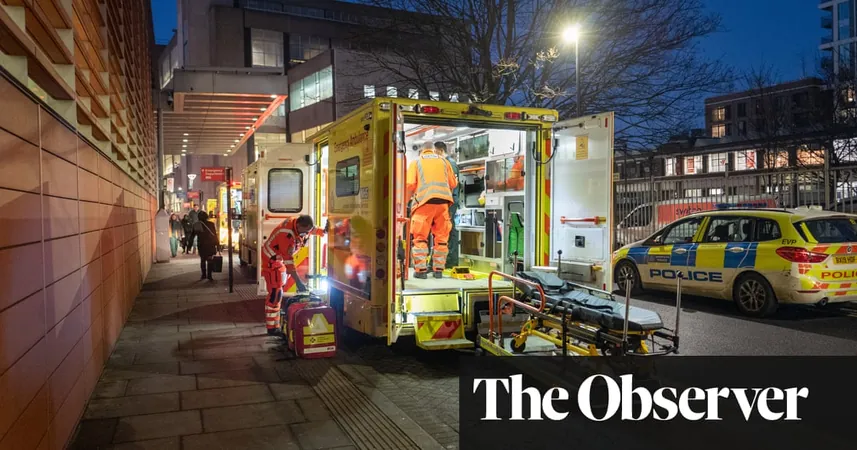
Alarming Report: Only 15% of A&E Departments in England Prepared for Major Crises!
2025-01-11
Author: Arjun
In a shocking revelation, a recent study shows that just 15% of accident and emergency (A&E) department heads in England feel equipped to handle significant incidents, such as a terrorist attack or catastrophic rail disaster. This surprising statistic comes amidst a backdrop of overcrowded emergency wards that have left clinicians deeply concerned about the current state of the healthcare system.
The survey, involving clinical directors and consultants from 71 emergency departments, found that every participant reported overcrowding. A staggering 70% indicated that patients are forced to wait in corridors or ambulances for care more than half the time. Only 11 leaders expressed confidence that their facilities were "adequately prepared" to manage a major incident.
Published in the Emergency Medicine Journal, the research conducted by academics from Derriford Hospital in Plymouth and the Royal Centre for Defence Medicine in Birmingham shed light on the deteriorating conditions in A&E. Alarmingly, the ongoing NHS winter crisis has made 2024 the busiest year on record for emergency services, according to NHS England.
Last week alone, an average of 5,407 patients with flu were treated each day, a staggering increase compared to the same period last year. This surge has led to ambulances queued outside emergency departments, unable to offload patients due to the lack of available beds. Inside the wards, about 12,591 patients have been medically cleared for discharge but are stuck due to insufficient social care placements, with 70.6% of patients facing delays, according to the Royal College of Emergency Medicine (RCEM).
Dr. Adrian Boyle, president of the RCEM, stated, "This is not merely a winter crisis driven by respiratory viruses. The healthcare system has been in crisis all year, proving the lack of bed capacity and escalating workload are the real culprits." He emphasized that many emergency departments are now facing an overwhelming number of patients waiting for admission—not just in corridors but even outside in ambulances, which is increasingly alarming.
In response to the escalating crisis, over 20 hospital trusts have implemented critical incident protocols, allowing for the postponement of elective procedures to reallocate resources to A&E departments. Major incidents, including mass casualty events like train crashes or terrorist attacks, require hospitals to have a plan in place, collaborating with local emergency services. However, experts have raised concerns regarding the real-world application of these plans given the current level of overcrowding.
Professor Lucy Easthope, an adviser on disaster response and author of "When The Dust Settles," expressed her dread about the implications of a sudden major incident under these conditions. She remarked, "While some A&Es might manage a no-notice major incident in theory, the implications for already overwhelmed hospitals could be catastrophic."
With eyewitness accounts of heightened public frustration when disaster victims receive priority care, planning for such events assumes an unsettling importance. Easthope noted, "If the congestion in A&Es continues, disaster response teams might need to rethink how they provide care—perhaps even resolving to treat victims at the scene instead of at overflowing hospitals."
Amid the rising criticisms, a spokesperson for NHS England acknowledged the immense pressures the NHS is currently under but highlighted ongoing efforts to ensure that robust major incident plans are in place across the board. "A lot of planning and practice occurs for major incidents, including leveraging support from neighboring hospitals and voluntary groups," they affirmed.
As England grapples with this alarming reality, one must ponder: if our emergency departments can barely cope with everyday pressures, how prepared are we really for a true catastrophe? Stay tuned as this story develops and continue to advocate for critical changes in the NHS!



 Brasil (PT)
Brasil (PT)
 Canada (EN)
Canada (EN)
 Chile (ES)
Chile (ES)
 Česko (CS)
Česko (CS)
 대한민국 (KO)
대한민국 (KO)
 España (ES)
España (ES)
 France (FR)
France (FR)
 Hong Kong (EN)
Hong Kong (EN)
 Italia (IT)
Italia (IT)
 日本 (JA)
日本 (JA)
 Magyarország (HU)
Magyarország (HU)
 Norge (NO)
Norge (NO)
 Polska (PL)
Polska (PL)
 Schweiz (DE)
Schweiz (DE)
 Singapore (EN)
Singapore (EN)
 Sverige (SV)
Sverige (SV)
 Suomi (FI)
Suomi (FI)
 Türkiye (TR)
Türkiye (TR)
 الإمارات العربية المتحدة (AR)
الإمارات العربية المتحدة (AR)